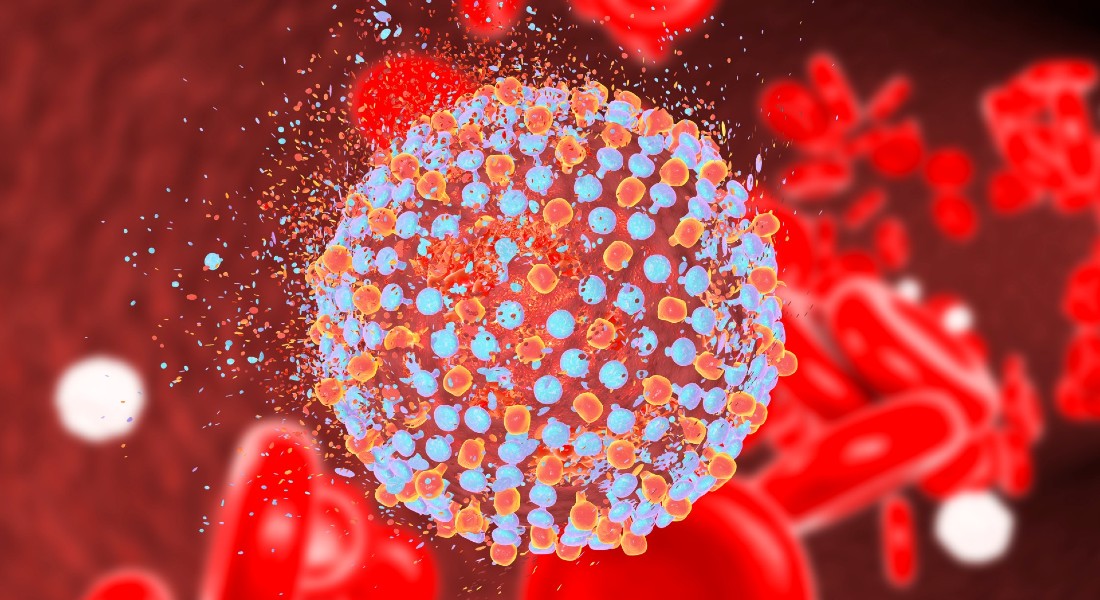Enabling a vaccine against chronic liver disease
Hitherto, all attempts to find a vaccine against the viral disease hepatitis C have been in vain. Now, however, University of Copenhagen researchers have succeeded in mapping a key protein in the virus, thereby providing a clear vaccine target.

Worldwide, some 58 million people suffer from the liver disease chronic hepatitis C, which leads to about 290,000 deaths annually. Researchers at the University of Copenhagen have mapped the structure of the key protein complex of the virus causing the disease. Their discovery is now published in the prestigious scientific journal Nature.
”During the Covid-19 pandemic we all learned how the so-called spike protein is central to the corona virus and the primary vaccine target. The protein we have mapped does not resemble a spike, but its function is the same. Namely to help the hepatitis C virus enter the human cells, while simultaneously avoiding attacks from the immune system. If this protein can be effectively targeted and neutralized by the immune system, the infection can be stopped,” says Associate Professor Jannick Prentø, Department of Immunology and Microbiology (ISIM), University of Copenhagen.
The mortality from hepatitis C is mainly associated with increased risk of contracting other diseases, among them liver cancer.
“Only if the infection becomes chronic will hepatitis C be dangerous. Today, the infection will stop spontaneously in some 30 per cent of those infected. These people do not have symptoms. So, if we can bring that number close to 100 per cent through vaccination, grave consequences will be practically eliminated. Notably, programs targeting the general population will not be needed. Just vaccinating those at risk of contracting the virus should suffice,” Jannick Prentø explains.
The virus has a surprising structure
Since a vaccine against hepatitis B was introduced many decades ago, the incidence of this virus has been dramatically reduced. Several attempts to develop a vaccine for hepatitis C have been made, but all in vain.
“These attempts have been made without a clear perception of the target for the vaccines. Now, we have provided a map of that target,” the ISIM researcher notes.
Proteins can be very large molecules, and their structures difficult to map. Furthermore, researchers in the field have been under a flawed assumption about the hepatitis C key protein complex. It was believed to be a so-called trimer, meaning composed of three repeated units in a symmetrical structure.
“The equivalent complexes in HIV, flu virus, and Corona are all trimers, and the expectation was for this to be the case for hepatitis C as well. When we initiated the project, we were certain that we would be looking for a trimer. That was even stated in the title for the project! However, our study has shown the complex to be a dimer, meaning it is composed of two repeated units,” Jannick Prentø reports.
This finding has huge implications for how to approach developing a vaccine.
The race to develop a vaccine begins
The studies have combined biotechnological methods in which the protein sequences have been mapped, with cryo electron microscopy (cryo-EM) allowing observations of the physical structure of the molecule at close to atomic scale.
Jannick Prentø’s group operates as a unit in the Copenhagen Hepatitis C Program (CO-HEP) led by Professor Jens Bukh at the Department of Immunology and Microbiology (ISIM) at the University of Copenhagen and Department of Infectious Diseases at Hvidovre Hospital. However, the project has benefitted greatly from inter-departmental collaboration with researchers at the Biomedical Institute (BMI) at the University of Copenhagen. The experience of researchers Associate Professor Pontus Gourdon and Kaituo Wang helped enable the determination of the structure using cryo-EM.
When Jannick Prentø originally got the idea for the project, it was initially directly funded by a Lundbeck Foundation Experiment grant, aimed at supporting high-risk ideas, and was subsequently also supported by the Novo Nordisk Foundation (NNF) BRIDGE – Translational Excellence Programme for Elias Honerød Augestad. A new project led by Jannick Prentø, aiming to use the structure to develop a hepatitis C vaccine, is also funded by NNF.
“Now, as we publish the structure of the protein complex in Nature, many research groups will attempt to develop a vaccine. This is how things should be – getting a vaccine is what’s important. However, we will do our best to exploit the jump start we have. We have not been idle since we learned that Nature accepted our manuscript,” says Elias Honerød Augestad, Postdoc. He and Christina Holmboe Olesen are shared first authors of the study.
Perspectives beyond hepatitis C
The NNF grant will cover the next five years of vaccine research.
“Within that time horizon we expect to have one or more vaccine candidates ready,” says Jannick Prentø while noting that it would not be the end of the world if another group develops a vaccine faster:
“We would like to be first, but the most important thing is to have the best vaccine! Moreover, the new discovery may trigger other breakthroughs. Hepatitis C belongs to the Hepaci-virus genus, and this is the first reported structure of this key protein complex in a virus from this group. This may pave the way for similar discoveries for other Hepaci-viruses. Also, several of the methods we have applied in the project could be interesting in developing vaccines for other diseases besides hepatitis C.”
The scientific article in Nature to be found here: The hepatitis C virus envelope protein complex is a dimer of heterodimers
Contact
Associate Professor and group leader, Jannick Prentø
Copenhagen Hepatitis C Program (CO-HEP)
Department of Immunology and Microbiology (ISIM), University of Copenhagen, and Department of Infectious Diseases, Copenhagen University Hospital, Hvidovre
jprentoe@sund.ku.dk
+45 22 89 99 97
